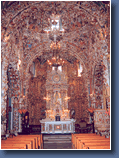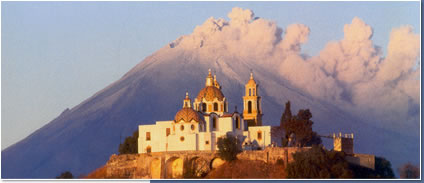Getting
to Puebla:
From Mexico City International Airport, Estrella Roja buses depart
for Puebla every half hour, with the last bus of the night leaving
at 12:20 a.m. The fare was 130 pesos (= about US$ 11.60) in August
2004.
From Mexico City's TAPO, the eastern bus terminal, fares are slightly
lower and service is available almost 24 hours a day via Estrella
Roja and ADO (Autobuses de Oriente) bus lines. Buses depart every
five minutes from 6:00 a.m. to midnight.
Express, non-stop service with guaranteed seating is available every
15 or 20 minutes. The departure time for your bus is printed on
the ticket, and tickets are non-refundable. Travel time between
Mexico City and Puebla by express bus is 1 hour and 50 minutes.
Buses arrive at Puebla's main terminal, the Central de Autobuses
Puebla (CAPU), in the northwest sector of the city.
The Estrella Roja bus line also makes a stop further south (at 4
Poniente, near 11 Norte), which is closer to the Historic District.
Taxis and Buses in Puebla: At the CAPU bus terminal and elsewhere
in the city, kiosks sell government-authorized taxi rides at flat
rates to specific destinations. Pay the attendant at the kiosk for
your ticket. Pay no money to the driver except for an appropriate
tip (10% of the fare). A map at the kiosk tells you the fare zone
for your destination.
Public buses are plentiful and cheap (3.50 pesos in August 2004),
but you should carry exact change. If you need to hail a taxi in
the street, which is not recommended, use only marked cabs and negotiate
the fare with the driver before accepting the ride. Always write
down the taxi identification number for your protection.
Puebla (pronounced PWEH-BLAH) is located
in the Puebla Valley, 129 km (80 miles) southeast of Mexico City.
Altitude: 2,149 m. (7,091 ft.). Population in 2000: 1,346,000.
It is the capital of the state of Puebla and one of Mexico's oldest
Spanish cities, founded in 1531. Puebla is reknown for its distinctive
colonial architecture, savory cuisine, Talavera ceramics, onyx
crafts, and textile industry. The indigenous language of the region,
Náhuatl, is still spoken in some rural areas of the Puebla
Valley. In 1987, UNESCO designated Puebla a World Heritage City.
:
The Mexican currency is the peso ($). The present
with the U.S. dollar is about $11.20 = 1.0USD. Many
local stores and branch banks do not accept foreign travelers
checks, U.S. dollars, or credit cards. Change money at the
Mexico City International Airport, which offers the best exchange
rates. Or visit the central office of any bank in downtown
Puebla or Cholula (the currency exchange window), Monday through
Friday, before 1:00 p.m. Ask for at least 100 pesos in small
bills and coins. Taxis, buses, and smaller stores often refuse
to change anything larger than a 50 pesos bill. Foreign credit
cards are accepted in major restaurants, stores, and hotels.
Best exchange rates are found in CASAS de CAMBIO (exchange
houses) open only on weekdays, usually from 9 am to 5 pm,
in downtown Cholula there are several of them. . Most banks
open only on weekdays, also from 9 am to 5 pm. USA cash or
travelers checks are easier to change into pesos than other
types of currency. In INAOE there is an ATM (cash machine).
|
 |
| |
:
Sunny days (70-80o F, or 21.1 -26.6o C) and chilly nights
(40-50o F, or 4.4-10o C) mean you'll need layers of clothing
and warm pijamas. There is almost no precipitation from
November through March. Afternoons are rainy from April
through October. We strongly recommend that you bring a
good jacket.
:
Spanish is the official language in Mexico. And in Puebla
very few people speak English. We advise you to have a good
dictionary and a
when you venture out. |
Food: Mexican cuisine is among the best in the world, but those visiting for the
first time should take some precautions. Mole poblano, a chocolate-chile
sauce poured over turkey or chicken, was invented in Puebla. It
is Mexico's national dish. Other poblano specialties include:
chiles en nogada, meat-stuffed green peppers covered with a walnut-pomegranate
sauce; sweet-potato candies called camotes; and tacos arabes,
spit-roasted, seasoned pork served in puffy wheat tortillas, a
dish invented by Middle Eastern immigrants. There are some spicy
sauces (salsas picantes) which could be very aggressive to unaware
mouths: before adding any sauce to your food, try a small amount
of it in a piece of bread. Avoid consuming tap water, ice cubes,
and foods sold by street vendors, especially water-based desserts.
Use bottled water, even for brushing your teeth, and ask for beverages
without ice.
Mexican culture and .
.

|



